Native Son – May, 2011
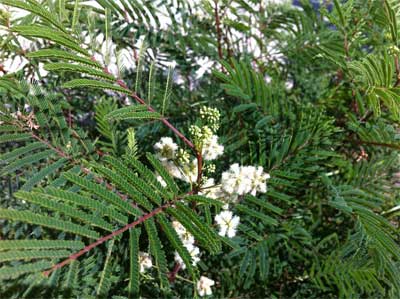
Fern acacia (Acacia angustissima). The writer has watched an “ugly duckling bush” grow into a swan. All photos by Steven Chamblee.
Fern Acacia & Sensitive Mimosa
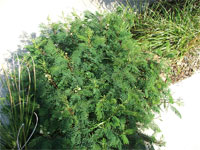
Fern acacia at Chandor Gardens
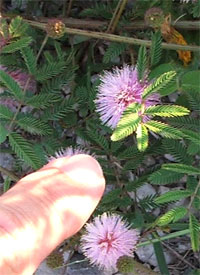
Sensitive Mimosa leaves before touching
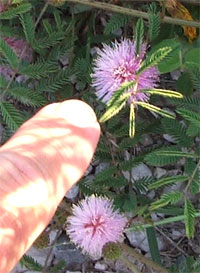
Sensitive Mimosa leaves reacting to touch
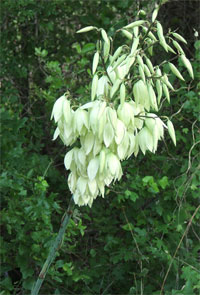
Yucca pallida
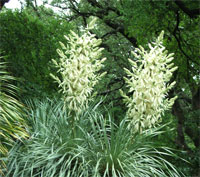
Yucca rostrata
About two years ago, a plant guy from Arizona had me on the phone, trying to coax me into sampling a few pots of fern acacia (Acacia angustissima). He described it as a pretty darn decent little prairie plant — 2 feet tall, tough, drought-tolerant, with fern-like leaves and delicate, fuzzy, cream-colored flowers, one of the few acacias without thorns … and it was a Texas native. Well, who could resist that?
When the plants arrived, they were unimpressive. Hmmmp…. I wondered if I had indeed been duped, or if they just needed the tincture of time to bring them to beauty … after all, I was kind of a late bloomer myself. I planted them out on the edge of the parking lot at Chandor Gardens — a rather horrid location surrounded by a small sea of concrete and no shade in sight. I reasoned that if they were destined to disappoint, then not many folks would have to suffer the sight of them.
That first summer was nothing to write home about, and I was glad I had not put them front and center in the garden. The foliage was nice, and indeed fern-like, but it was pretty sparse, as were the blooms. In autumn, the leaves barely colored a dull yellow before falling off, leaving some skinny stems sticking up into the air. Overall, I was unimpressed and chalked it up to experience.
Well, time passes. The winter was murder, and some stuff died that we expected to live (some Loropetallum and an Azalea), and some other stuff lived that we expected to die (Chlorophyllum and two species of Bauhinia). Spring was a crazy balancing act of hot and dry and wind and hail, and I had all but forgotten about the fern acacia until this morning, when I happened to notice a frothy mass of deep, velvety green foliage waving to me from the far end of the parking lot. Halfway to it, I could see it was sprinkled with a few fuzzy flowers. When I arrived to say hello, she looked up at me cheerily, as if to say, “Take a look at me now, Daddio!” Indeed, the ugly duckling had grown into a swan.
The dark green leaves are divided into leaflets, each of which is then divided again into the tiniest of sub-leaflets, all precisely lined up like “sugar ant surfboards” along the brick red petioles. The red color continues down the stems, and makes a nice contrast to the foliage. Tiny developing buds tell me that this season’s flowering has just begun. When I stroke the irresistible fine foliage with my hand, it literally starts to melt in my fingers. I was unaware that this is one of those rare plants that react to touch, a trait referred to as “thigmonasty.”
Venus fly trap (Dionaea muscipula) and sensitive mimosa (Mimosa roemeriana) are the most famous thigmonastic plants, each capable of dramatic quick movements. The Venus fly trap plant can rapidly close its “trap” because certain cells at the hinge of the trap lobes suddenly elongate. The sensitive mimosa (one of some 400 mimosa species and an entirely different genus from the shade tree familiar to us, Albizzia julibrissin) has leaves that can droop abruptly because it has special cells called pulvini that quickly lose turgor (cell pressure) when activated, allowing the entire leaf to suddenly wilt. Interestingly enough, the Venus fly trap closes to eat; sensitive mimosa, it is thought, droops to avoid being eaten.
Scientists haven’t quite figured out the complete story on how the plants do this, but the same principles that move tiny plant parts have been applied to many human endeavors, including a wide variety of hydraulic equipment, from tractors and cranes to those colossal hydraulic sea walls. (A quick side note: plants that close their leaves or flowers at night are referred to as “nyctinastic.” They do this in response to an innate “circadian rhythm,” which is a mind-altering complex formula of inputs and variables that I’ll just describe as, “nature’s little nudge that makes the world go round.”)
A few minutes later, I’m rummaging around the back forty, searching for a sensitive mimosa in bloom, so I can show you photos. I found one, nestled among the forest of Yucca pallida flowering their silly little heads off — which reminds me to tell you that Chandor Gardens’ magnificent Yucca rostrata is in flower! These twin inflorescences are about 6 feet tall, but don’t last long. Come on over and check them out.
Peace & love,
Steven

Proud pop and son, Danny Chamblee, celebrate high school graduation this week. Congratulations from e-gardens readers and staff.
About the author: Steven Chamblee is the chief horticulturist for Chandor Gardens in Weatherford and a regular contributor to Neil Sperry’s GARDENS magazine and e-gardens newsletter. Steven adds these notes:
Apology: In my haste last month, I said that Miranda Bloom is located in Robert, Texas. Actually, it is in Rogers, Texas. Please accept my apologies.
Spring is in full swing at Chandor Gardens! Come and visit the gardens while spring is still flaunting its finery. Just take I-20 west to exit 409, hang a right, go 2.1 miles and hang a left on Lee Avenue. Head straight 12 blocks and you’re driving in the gates. Call 817-361-1700 for more information. You can always go to www.chandorgardens.com for a picture tour and more information.
I can always use another road trip! Let me know if you’d like me to come out and speak to your group sometime. I’m low-maintenance, flexible, and you know I like to go just about anywhere. No city too big; no town to small. Just send me an e-mail at schamblee@weatherfordtx.gov and we’ll work something out.

